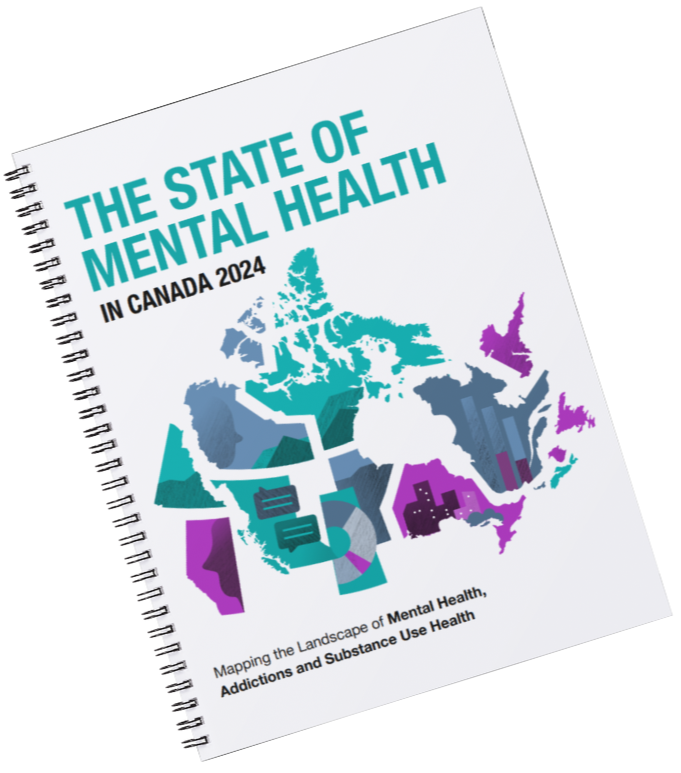Menu
Close

State of Mental Health in Canada Report 2024
Dec 2, 2024
The state of mental health in Canada? It’s alarming, a new Canadian Mental Health Association report finds.
Research shows that no province or territory is spending what they should be on mental health, in part because they’re not obliged to.
Through a first-of-its-kind report, the Canadian Mental Health Association (CMHA) is providing an in-depth look at the mental health system in Canada—with all its cracks and failings— and how people are faring, in every province and territory. What it reveals is troubling.
Among the findings of The State of Mental Health in Canada 2024 is that no jurisdiction is spending enough on mental health, in part because they’re not obliged to. Provinces and territories are only spending an average of 6.3% of their overall health budgets on mental health, which leaves Canada lagging behind many peer countries (15% in France, 11% in Germany, 9% in the UK and Sweden). This doesn’t even meet the level of spending called for in Canada’s own, stale-dated mental health strategy.
In 2024-2025, mental health accounted for 5.9% of budgeted health care spending in Ontario.
In total, this deep-dive report showcases 24 indicators of the state of mental health in Canada, from how much is being spent on care, to rates of suicide and levels of discrimination against people with mental health concerns—all broken down province and territory. The most recent statistics from the report show that the mental health of Canadians is three times worse than before COVID-19 and millions of people can’t get the care they need.
Furthermore, “Where you live matters,” said Dr. Leyna Lowe, National Senior Research and Policy Analyst, CMHA, and the lead author of the report. “The report tells us that people receive drastically different care depending on their home province or territory, and that people across Canada are doing worse in some places, particularly in the north and in rural parts of Canada, and distress is higher among Indigenous and racialized populations.”
As it stands, accessing mental health care in Canada is often a privilege when it should be a fundamental right. CMHA’s report shows that millions of people in need of support aren’t getting it—an alarming reality with real consequences.
“I was admitted to the hospital for suicidal ideation and their only goal was to stop me, not to ensure that I had help or support afterwards to get to the root of the issue,” said Caroline, a member of CMHA’s National Council of Persons with Lived Experience. “There was zero follow-up once I was released from the hospital; just ‘bonne chance’ and a card with some numbers to call.”
However, The State of Mental Health in Canada 2024 also highlights promising innovations through a series of actionable recommendations. This report gives decision makers a roadmap to better mental health care.
“Mental health has been profoundly neglected under universal health care since Medicare was introduced forty years ago,” said Sarah Kennell, National Director of Public Policy, CMHA. “Six federal governments in a row have failed to deliver free, universal mental health care and Canadians are living with—and sometimes dying from—the consequences.”
CMHA is calling on the federal government to write mental health care into federal law. The federal government must also prioritize the mental health and well-being of Canadians by investing 12% of health care spending in mental health, addictions, and substance use services. By doing so, we can support a future where mental health care is a fundamental right for everyone.
Key statistics from the State of Mental Health in Canada 2024 (Ontario)
- While the number of psychiatrists is slightly higher (13.4/100,000) than the Canadian rate (13.1/100,000), psychiatrists are concentrated in large urban centres.
- The high cost of housing affects many Ontarians: 18.1% of Ontarians with poor-to-fair mental health can’t get the housing they need (“core housing need”) compared to 15.8% nationally.
- Among those who receive disability income supports in Ontario, up to 50% report having a mental illness or substance use disorder.
- 47% increase in emergency department visits for mental health, addictions and substance use health (MHASU) care, and a 23% rise in the hospitalization rate. The hospitalization rate for youth ages 14-17 with MHASU concerns increased by an alarming 136%. (2021)
- Data show that Ontario is on par with the national average for most of the indicators in the report.
- Rate of apparent opioid toxicity deaths (16.6 per 100,000), although lower than Canada’s rate (20.8 per 100,000), is up significantly from the pre-pandemic 2019 rate (10.6 per 100,000).
Government response:
- In 2024-25, Ontario will spend approximately $2 billion on mental health, which amounts to 5.9% of the overall health budget (compared to the national average of 6.3%).
- Ontario is spending a greater percentage of the bilateral health investments in mental health, addictions and substance use health (MHASU) care: 40.5% compared to 31% nationally.
- Expansion of the Ontario Structured Psychotherapy Program (OSP), which provides free cognitive behavioural therapy for people experiencing depression and anxiety.
Of great concern:
Ontario’s entire healthcare sector is facing a crisis in health human resources (HHR), including a shortage of mental health service providers and a pay gap between community and other providers. The Ontario Government has been shifting its support for harm reduction to bed-based addictions.

